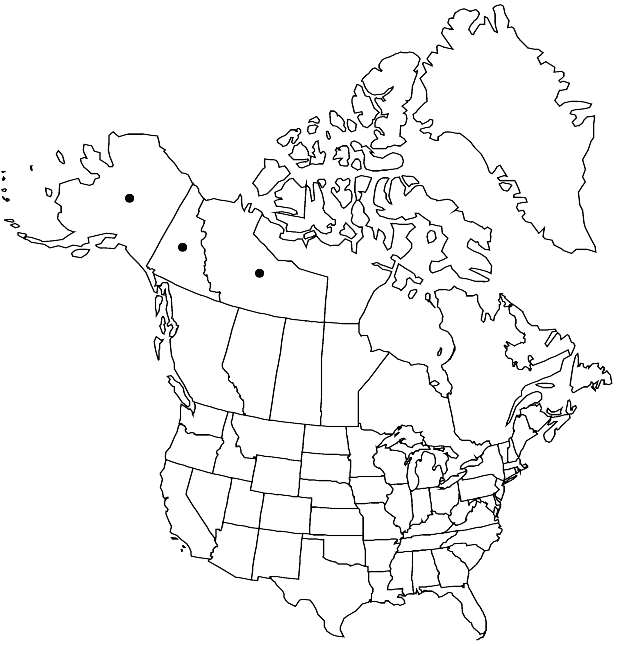Salix phlebophylla
Proc. Amer. Acad. Arts 4: 72. 1858.
Plants 0.01–0.07 m, (dwarf), forming clonal mats by rhizomes. Stems trailing; branches redbrown or yellowbrown, glabrous; branchlets redbrown, glabrous. Leaves (prominently marcescent, becoming skeletonized); stipules absent or rudimentary; petiole (deeply grooved or convex to flat adaxially), 1.2–3.2 (–4.8) mm, (sparsely pubescent adaxially); largest medial blade amphistomatous, (2 pairs secondary-veins arising at or close to base, arcing toward apex), elliptic, broadly elliptic, obovate, subcircular, or circular, 7–15 × 3–11 mm, 1.1–2.5 (–3.5) times as long as wide, base convex or cuneate, margins flat, entire, sometimes ciliate, apex convex, rounded, or retuse, abaxial surface not glaucous, glabrous, midrib sometimes pilose, hairs long, straight, wavy, or crinkled, adaxial highly glossy, glabrous; proximal blade margins entire; juvenile blade (green), glabrous abaxially or ciliate. Catkins: staminate 10–35 × 6–10 mm, flowering branchlet 1–11 mm; pistillate moderately densely flowered, stout or subglobose, 12–38 × 5–11 mm, flowering branchlet 3–14 mm; floral bract brown, black, or bicolor, 1–1.3 mm, apex rounded, entire, abaxially sparsely hairy, hairs straight or wavy. Staminate flowers: abaxial nectary absent, adaxial nectary narrowly oblong or oblong, 0.4–1.1 mm; filaments distinct or connate less than 1/2 their lengths, glabrous; anthers ellipsoid or obovoid, 0.3–0.5 mm. Pistillate flowers: abaxial nectary absent, adaxial nectary oblong or narrowly oblong, 0.4–1.6 mm, shorter than or equal to stipe; stipe 0.4–1.4 mm; ovary pyriform, sparsely to moderately densely short-silky or villous, at least on beaks, hairs ribbonlike, beak slightly bulged below styles; ovules 12 per ovary; styles connate or slightly distinct distally, 0.3–1 mm; stigmas flat, abaxially non-papillate with rounded tip, or slenderly to broadly cylindrical, 0.16–0.34–0.52 mm. Capsules 2.9–4.8 mm. 2n = 38.
Phenology: Flowering Jun–Jul.
Habitat: Arctic-alpine, dry Dryas-lichen tundra, polygonal tundra with stone stripes and dry raised centers, scree and colluvial slopes, grass-sedge tussock tundra, sedge meadows in drainage ways, dwarf birch thickets, granitic and sandstone substrates
Elevation: 0-2100 m
Distribution

N.W.T., Yukon, Alaska, e Asia (Chukotka), e Asia (Russian Far East), e Asia (arctic), e Asia (e Siberia)
Discussion
Hybrids:
Salix phlebophylla forms natural hybrids with S. arctica, S. fuscescens, and S. rotundifolia.
Salix phlebophylla × S. rotundifolia has hairy ovaries, some skeletonized leaves, a compact growth form that may lack rhizomes, and catkins with more than 15 flowers. It occurs on the Alaska arctic slope, outside the range of S. polaris.
Selected References
None.
Lower Taxa
"-0.52mm" is not declared as a valid unit of measurement for this property.